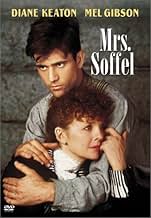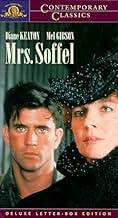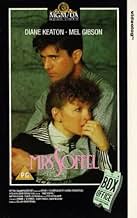CALIFICACIÓN DE IMDb
6.1/10
3.7 k
TU CALIFICACIÓN
Diane Keaton interpreta a la esposa de un alcaide de prisión que se enamora de un condenado a muerte (Mel Gibson). Creyendo que es inocente, le ayuda a él y a su hermano convicto a escapar.Diane Keaton interpreta a la esposa de un alcaide de prisión que se enamora de un condenado a muerte (Mel Gibson). Creyendo que es inocente, le ayuda a él y a su hermano convicto a escapar.Diane Keaton interpreta a la esposa de un alcaide de prisión que se enamora de un condenado a muerte (Mel Gibson). Creyendo que es inocente, le ayuda a él y a su hermano convicto a escapar.
- Dirección
- Guionista
- Elenco
- Premios
- 3 nominaciones en total
Jennifer Dundas
- Margaret Soffel
- (as Jennie Dundas)
- Dirección
- Guionista
- Todo el elenco y el equipo
- Producción, taquilla y más en IMDbPro
Opiniones destacadas
Australian director Gillian Armstrong makes great films with strong women characters--her earlier Australian film "My brilliant career" being a perfect example. I watched "Mrs. Soffel" because of my admiration for Armstrong and found that "Mrs. Soffel" could not hold a candle to "My brilliant career" even though American actress Diane Keaton was admirable compared to the Australian actresses in the latter.
Armstrong had the talented Australian cinematographer Russel Boyd (who was responsible for the seminal works of Peter Weir and Bruce Beresford) once again to work with. While Armstrong and Boyd used justifiably darkened interior shots, I had problems seeing anything for long periods and had to rely on the soundtrack!
Armstrong loves to develop the female characters but leaves the male characters totally undeveloped (Mr Soffel and Jack Biddle). This is one reason I prefer the works of Weir and Beresford over Armstrong--even though her latent talent cannot be ignored. It is amazing to see Soffel's daughter getting equal or more prominence in the script than Mr Soffel towards the end.
Mel Gibson has made a name for himself by directing "Braveheart," but I give more credence to his acting phase in Australia ("Tim", "Mad Max", etc.). I am convinced that he is a director's actor--doing well with good directors. In "Mrs Soffel" Armstrong has evidently invested time with Diane Keaton, who carries the film. Gibson only lends support to her thanks more to the script than his acting capabilities.
Most of the fine tribe of Australian filmmakers of the Seventies have drifted to the US to become richer and gain international recognition--but their work in Australia in the Seventies remains unsurpassed.
Armstrong had the talented Australian cinematographer Russel Boyd (who was responsible for the seminal works of Peter Weir and Bruce Beresford) once again to work with. While Armstrong and Boyd used justifiably darkened interior shots, I had problems seeing anything for long periods and had to rely on the soundtrack!
Armstrong loves to develop the female characters but leaves the male characters totally undeveloped (Mr Soffel and Jack Biddle). This is one reason I prefer the works of Weir and Beresford over Armstrong--even though her latent talent cannot be ignored. It is amazing to see Soffel's daughter getting equal or more prominence in the script than Mr Soffel towards the end.
Mel Gibson has made a name for himself by directing "Braveheart," but I give more credence to his acting phase in Australia ("Tim", "Mad Max", etc.). I am convinced that he is a director's actor--doing well with good directors. In "Mrs Soffel" Armstrong has evidently invested time with Diane Keaton, who carries the film. Gibson only lends support to her thanks more to the script than his acting capabilities.
Most of the fine tribe of Australian filmmakers of the Seventies have drifted to the US to become richer and gain international recognition--but their work in Australia in the Seventies remains unsurpassed.
This is a visually beautiful movie bringing the story along in with obvious and subtle references.
The title character is a trapped woman. The 'noblesse oblige'of being the warden's wife coupled with her own frustrations and frailties makes her life intolerable. She loves her children; she hates her life.
Here, she becomes intrigued by a prisoner in her husband's jail. He appeals to her imagination as well as her sensibility as a woman. She finds a soul-mate in their exchanges as she pretends to read-him-to-reform from bible passages. She flees with him and is willing to die with him to keep from returning to her unbearable life.
This is based on a true story. But it is a telling of the story of women, most of whom until the last 25 years or so, had little choice but to marry and to identify themselves in terms of their husbands. Their identity was not their own; their choices had to be appropriate to their marriage station; they were judged by how well they maintained husband's well being and their children's achievements.
While much has changed in women's lives, vestiges of the past still do exist. The references to "baking cookies" in the 2004 presidential campaign signals this.
Mrs. Soffel represents the lives of women over time. She desperately seeks the love and freedom that her standing in life denies her. This has been a common women's theme.
The title character is a trapped woman. The 'noblesse oblige'of being the warden's wife coupled with her own frustrations and frailties makes her life intolerable. She loves her children; she hates her life.
Here, she becomes intrigued by a prisoner in her husband's jail. He appeals to her imagination as well as her sensibility as a woman. She finds a soul-mate in their exchanges as she pretends to read-him-to-reform from bible passages. She flees with him and is willing to die with him to keep from returning to her unbearable life.
This is based on a true story. But it is a telling of the story of women, most of whom until the last 25 years or so, had little choice but to marry and to identify themselves in terms of their husbands. Their identity was not their own; their choices had to be appropriate to their marriage station; they were judged by how well they maintained husband's well being and their children's achievements.
While much has changed in women's lives, vestiges of the past still do exist. The references to "baking cookies" in the 2004 presidential campaign signals this.
Mrs. Soffel represents the lives of women over time. She desperately seeks the love and freedom that her standing in life denies her. This has been a common women's theme.
This is one of the best American films of the 1980's. It is based on the true story of the wife of the Allegheny County Jail warden, Kate Soffel (Diane Keaton) who falls in love with a sexually alluring working class inmate, Ed Biddle (Mel Gibosn) in turn of the century Pittsburgh and plots to help him and his brother, Jack (Matthew Modine) escape. Director Gillian Armstrong and screenwriter Ron Nyswaner brilliantly decided to deal with the story in an elliptical and indirect way. We aren't telegraphed anything. We don't know if the Biddle's are innocent. We don't really understand why Kate falls in love with Ed. We aren't directly told why Kate is so disappointed in her life. The filmmakers takes this personal story and turns it into a progressive feminist mood poem. It is extraordinary to see a post 1970's American film this complex and this progressive.
Diane Keaton gives a remarkably complex and nuanced performance. The film is almost unimaginable with her in the leading role. Early in the film she communicates the torment and longing of Kate in a way that warrants comparisons with the greatest acting of the silent cinema. We see the depression and desperation in Kate's face in a way that rivals Maria Falconetti in Dryer's THE PASSION OF JOAN OF ARC and Lilian Gish in Victor Sjöström's THE WIND and D.W. Griffith's BROKEN BLOSSOM'S. One of the remarkably subversive aspects of the film is its relationship to Kate's Christianity (which becomes particularly pointed watched in the contemporary context and thinking about Mel Gibson's PASSION OF THE Christ fundamentalism). She is a bit scary creeping about the prison trying to sell doomed men on a faith that will set them free. The suggestion is that it is this same faith, or more precisely the way Christianity is used as a structuring device of patriarchy, that has trapped Kate into her own life sentence. When she becomes aroused by Ed everything shifts, she looks different, some kind of remarkable radiance shines forth from Keaton's face. Her bible lessons become a pretext for sexual release. She literally makes love to Ed through the bars with his brother nearby, which adds a remarkable charge of voyeurism to the proceedings.
Mel Gibson has never been photographed more sensually then in this film. There is a scene late in the film, in which, he is lying in bed with the sunlight playing on his face that in which his beauty is almost angelic. He's photographed and contextualized the way male directors have often shot young classically beautiful women (think of Julie Christie in David Lean's Dr. ZHIVAGO, Joseph Losey's THE GO BETWEEN, or Donald Cammell's DEMONSEED or Faye Dunaway in Roman Polanski's CHINATOWN or Sydney Pollock's 3 DAYS OF THE CONDOR). Armstong also allows Gibson's sense of humor to peek out to suggest layers to this character. We never totally trust Ed, yet we root for him or at least root for Kate's vision of him.
The cinematography by Russell Boyd is exceptionally original and the production design emphasizes the grimy oppressive nature of an industrial town. this was actually a critique of the film at the time of its release. It was too dark, mainstream reviewers said. Well actually its historically accurate. Pittsburgh was so soot filled and grimy that the street lights had to stay on all day long! This is the great environmental tragedy of the industrial revolution. Armstrong uses this look for strong dramatic effect and creates a kind of mood poem here that reminds me of the best work of Antonioni and of Werner Herzog remarkable NOSFERATU. Like in that great film we can never quiet situate ourselves, the oppressive dim look of the film suggests we might be in a kind of waking nightmare. Is the environment part of Kate's psychic and physical affliction? Who could be happy or healthy living in this kind of relentlessly dismal environ? When we finally leave Pittsburgh Boyd and Armstrong present us with some of the most lovingly photographed images of sun and snow in American cinema. The viewer so ready for these brighter images that they alter our the way we connect to the story.
That this film was neither a critical nor a commercial success is a tragedy for the contemporary Hollywood cinema. Its failure became one of the many excuses for the overwhelming turn to the banal cookie cutter cinema that Hollywood is known for today. One hopes that cinephiles everywhere will reclaim ambitious films like MRS. SOFFEL as an example
Diane Keaton gives a remarkably complex and nuanced performance. The film is almost unimaginable with her in the leading role. Early in the film she communicates the torment and longing of Kate in a way that warrants comparisons with the greatest acting of the silent cinema. We see the depression and desperation in Kate's face in a way that rivals Maria Falconetti in Dryer's THE PASSION OF JOAN OF ARC and Lilian Gish in Victor Sjöström's THE WIND and D.W. Griffith's BROKEN BLOSSOM'S. One of the remarkably subversive aspects of the film is its relationship to Kate's Christianity (which becomes particularly pointed watched in the contemporary context and thinking about Mel Gibson's PASSION OF THE Christ fundamentalism). She is a bit scary creeping about the prison trying to sell doomed men on a faith that will set them free. The suggestion is that it is this same faith, or more precisely the way Christianity is used as a structuring device of patriarchy, that has trapped Kate into her own life sentence. When she becomes aroused by Ed everything shifts, she looks different, some kind of remarkable radiance shines forth from Keaton's face. Her bible lessons become a pretext for sexual release. She literally makes love to Ed through the bars with his brother nearby, which adds a remarkable charge of voyeurism to the proceedings.
Mel Gibson has never been photographed more sensually then in this film. There is a scene late in the film, in which, he is lying in bed with the sunlight playing on his face that in which his beauty is almost angelic. He's photographed and contextualized the way male directors have often shot young classically beautiful women (think of Julie Christie in David Lean's Dr. ZHIVAGO, Joseph Losey's THE GO BETWEEN, or Donald Cammell's DEMONSEED or Faye Dunaway in Roman Polanski's CHINATOWN or Sydney Pollock's 3 DAYS OF THE CONDOR). Armstong also allows Gibson's sense of humor to peek out to suggest layers to this character. We never totally trust Ed, yet we root for him or at least root for Kate's vision of him.
The cinematography by Russell Boyd is exceptionally original and the production design emphasizes the grimy oppressive nature of an industrial town. this was actually a critique of the film at the time of its release. It was too dark, mainstream reviewers said. Well actually its historically accurate. Pittsburgh was so soot filled and grimy that the street lights had to stay on all day long! This is the great environmental tragedy of the industrial revolution. Armstrong uses this look for strong dramatic effect and creates a kind of mood poem here that reminds me of the best work of Antonioni and of Werner Herzog remarkable NOSFERATU. Like in that great film we can never quiet situate ourselves, the oppressive dim look of the film suggests we might be in a kind of waking nightmare. Is the environment part of Kate's psychic and physical affliction? Who could be happy or healthy living in this kind of relentlessly dismal environ? When we finally leave Pittsburgh Boyd and Armstrong present us with some of the most lovingly photographed images of sun and snow in American cinema. The viewer so ready for these brighter images that they alter our the way we connect to the story.
That this film was neither a critical nor a commercial success is a tragedy for the contemporary Hollywood cinema. Its failure became one of the many excuses for the overwhelming turn to the banal cookie cutter cinema that Hollywood is known for today. One hopes that cinephiles everywhere will reclaim ambitious films like MRS. SOFFEL as an example
This one was a nice surprise, I hadn't seen it when it first came out, so I rented it and enjoyed it thoroughly. Diane Keaton and Mel Gibson carry the day in this true tale of a wardens wife who falls for a prisoner. Matthew Modine does a fine job as Mel Gibsons brother, and the entire cast is fine. It's beautifully shot in Pittsburgh, and there is a languid quality about it that I found alluring. Well done all around.
Continuing my survey/reevaluation of Mel Gibson movies (well, somebody has to do it), I give this one 3 stars out of 4. If I were giving stars. Anyway...beautifully photographed, nicely-directed film of warden's wife (Diane Keaton) in 1901 Pittsburgh, in contact with death-row inmate brothers (Mel and Matthew Modine). Diane's in static marriage with warden Edward Herrmann and four kids; goes to death row to read Bible passages to cons...one in particular...! Mel's waiting' on a hangin' while the darling of local starry-eyed schoolgirls lamenting the handsome con's apparent fate. Diane and Mel strike sparks in this period romance. Film is slow-moving in first half, but stick with it.
¿Sabías que…?
- TriviaThe jail used in the movie is the actual Allegheny County Jail that figures in the story. Designed by noted architect Henry Hobson Richardson, built between 1884-1888, it served as a jail until 1995 and is now used by the juvenile and family sections of the Common Pleas Court.
- ErroresA toy electric train shown running around a Christmas tree is of a post-1950 design, as is the track. The train is based on 19th-century locomotive and passenger car prototypes, making it more plausible. However, toy electric trains that even remotely resembled the one shown did not exist by 1901.
- Citas
Kate Soffel: Don't you let them take me alive, Ed. Promise me. Promise me, Ed.
Ed Biddle: I won't, I promise. I won't let them take you.
- ConexionesFeatured in The Making of 'Mrs. Soffel' (1984)
Selecciones populares
Inicia sesión para calificar y agrega a la lista de videos para obtener recomendaciones personalizadas
- How long is Mrs. Soffel?Con tecnología de Alexa
Detalles
- Fecha de lanzamiento
- País de origen
- Idiomas
- También se conoce como
- Flucht zu dritt
- Locaciones de filmación
- Productoras
- Ver más créditos de la compañía en IMDbPro
Taquilla
- Presupuesto
- USD 11,000,000 (estimado)
- Total en EE. UU. y Canadá
- USD 4,385,312
- Fin de semana de estreno en EE. UU. y Canadá
- USD 86,280
- 1 ene 1985
- Total a nivel mundial
- USD 4,385,312
- Tiempo de ejecución1 hora 50 minutos
- Mezcla de sonido
- Relación de aspecto
- 1.85 : 1
Contribuir a esta página
Sugiere una edición o agrega el contenido que falta

Principales brechas de datos
By what name was Mrs. Soffel (1984) officially released in India in English?
Responda




































